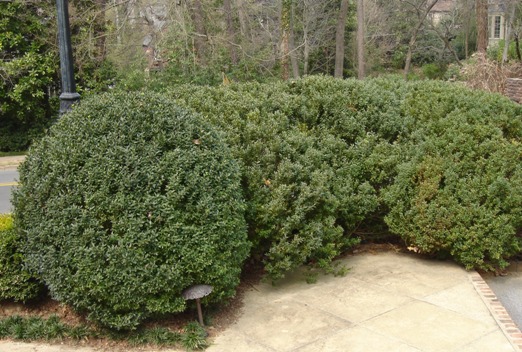
The Boxwood Doctor


The Boxwood Doctor is a specialty branch of Bradford Horticulture LLC that is set up to address the culture and care of the Boxwood plant. The Boxwood is one of the world’s oldest cultivated plants. History documents the Boxwood (genus Buxus ) as far back as 6,0000 years ago. The first Boxwoods were brought to North America in 1653. This ‘garden aristocrat’ was first used in Colonial times by the more affluent to grace the landscape around their mansions. Modern day gardeners have re-discovered the lasting qualities of the Boxwood. In general, they are considered an essential component of the traditional Southern home landscape. Some of America’s most famous homes, including the White House, George Washington’s home at Mount Vernon, and Colonial Williamsburg all have Boxwood as the essential base plant for the landscape. The proper culture and care of the Boxwood is essential if you expect to grow this beautiful plant in your landscape.
There are hundreds of different types of Boxwood, including the English Boxwood (B. sempervirens ‘suffruticosa’), the Japanese Boxwood (B. microphylla ‘japonica’), and the Korean Boxwood (B. sinica insularis) . Probably the most widely used Boxwood, however, is the American Boxwood or Common Boxwoood (B. sempervirens) and this plant can be one of the most challenging to grow.
Here is what Boxwoods need to grow well:
Choose a good location They grow best with morning sun and afternoon shade. The Japanese Boxwood is more tolerant of full sun, but they all grow better with shade during the heat of the day. Good soil drainage is essential to growing healthy plants. Improper irrigation practices and over watering may be the biggest problem we see with this plant.
Maintain a regular fertility program Boxwoods respond well to proper fertilization. We have found they are pretty heavy feeders. Also, be sure to maintain the correct soil pH (7.0 is the target pH). The only way to know what the Boxwood needs is to Soil Test.
Prune properly Use hand pruners to thin the branches and allow adequate light and air down into the plant. Avoid shearing or clipping except where a formal hedge is needed. Remember that wherever a cut is made, growth will start just below the cut. If you always shear the plant, all the new growth will be on the very outer edges. This growth will block light and air and often lead to disease problems. Look how much was removed from this boxwood and it's hardly noticeable.

Provide good Pest Management There are many diseases that cause problems such as Leaf Spot, Stem Blight and Root Rot. The most damaging insect pest of Boxwood is the Boxwood Leaf Miner. The larvae from the Leaf Miner feed inside the leaf and tunnel or mine the leaf. If your boxwoods are not protected they will usually get a Leaf Miner infestation. The damage caused by Leaf Miner is easily recognized by the irregular-shaped swellings or blisters on the leaf. The infested leaves are often off color and may drop earlier than healthy leaves. Other pests include the Boxwood Mite, Psyllids, and occasionally Scale.
Boxwood Mites can pop up quickly and cause an off color 'flecking' look to the leaves. Unfortunately, mite problems can sometimes occur because of the very insecticide used to contol leaf miner insects. The insecticide can kill off predator insects that feed on the mites and help hold down mite problems. In this case, it is better to deal with an occasional mite infestation than the much more destructive Boxwood Leaf Miner.
News - New Boxwood disease discovered in the US! Click here to learn more about 'Boxwood Blight'.
Don’t let this list of possible problems cause you to shy away from using Boxwoods in your landscape. If you provide all the care and maintenance, you have better chance of having a good healthy plant and years of beauty from this “Garden Aristocrate”.


Services Provided by Boxwood Doctor
Diagnosis and Evaluation This helps you determine what problems might exist and whether the Boxwood plant is salvageable or should be replaced. A proper Soil Test is the first step. Secondly, a lab examination may be needed to determine the exact cause of the problem or problems.
A Boxwood Maintenance Program This consists of a Winter dormant spray followed by a Spring treatment. These treatments are planned to meet the specific needs of your particular planting. Your boxwoods may also need Lime if called for on the soil analysis. The Spring treatment is a season long slow release fertilization, as well as corrective and preventative Soil Fungicide drenches and Insecticide treatments. We have formulated a product called Boxwood Special Care, BSC fertilizer. Click here to learn more about BSC. We have found that Boxwoods that are under a regular program such as this tend to have fewer problems and look better in the landscape over the long term.
Proper Pruning Keeping the Boxwoods open and clean inside allows for a healthy natural look to the plantings.
On-Going Monitoring Regular visits to look out for early signs of problems will help make the maintenance of these plants more successful. Boxwoods are slow to begin to show a problem, but it takes even longer to correct a problem.
Help with locating the best, most suitable replacement Boxwoods as well as supervision with plant selection and installation.